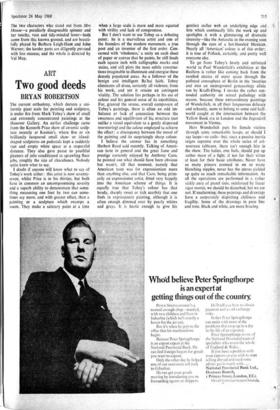Two good deeds
ART BRYAN ROBERTSON
The current orthodoxy, which decrees a uni- formly giant scale for painting and sculpture, is under fire from Mark Tobey's show of small and extremely concentrated paintings at the Hanover Gallery. An earlier challenge came from the Kenneth Price show of ceramic sculp- ture recently at- Kasmin's, where five or six brilliantly lacquered small shoe- or island- shaped sculptures on pedestals kept a suddenly vast and empty white space at a respectful distance. They also gave pause to youthful gleaners of info conditioned to sprawling floor jobs, roughly the size of charabancs. Nobody quite knew what to say.
I doubt if anyone will know what to say of Tobey's work either: this artist is now seventy- seven, whilst Price is in his thirties, but both have in common an uncompromising severity and a superb ability to demonstrate that some- thing measuring one foot by two can some- times say more, and with greater effect, than a painting or a sculpture which swamps a room. They make a salutary point at a time when a large scale is more and more equated with virility and lack of compromise.
But I don't want to use Tobey as a debating point: he is a' marvellous artist and one of the founders of the modern movement, a true poet and an inventor of the first order. Con- cerned with `wholeness,' a unity on each sheet of paper or canvas that he paints, he still loads each square inch with calligraphic marks and stains, and still plots the most subtle construc- tions imaginable to illuminate and energise these densely populated areas. As a follower of the benign and intelligent Ba'hai faith, Tobey eliminates all dross, certainly all violence, from his work, and yet it retains an astringent vitality. The solution lies perhaps in his use of colour and his general sense of its capabilities. For, granted the serene, overall composure of Tobey's paintings, there is often an odd im- balance or lack of connection between the sweetness and equilibrium of his structure (not unlike a visual equivalent to a gently dispersed murmuring) and the colour employed to achieve the effect: a discrepancy between the mood of the painting and its surprisingly sharp colour.
I believe the answer lies in something Herbert Read said recently. Talking of Ameri- can taste in general and the great fame and prestige currently enjoyed by Anthony Caro, he pointed out what should have been obvious but wasn't, till that moment, namely that American taste was for expressionism more than anything else, and that Caro, being prim- arily an expressionist artist, fitted very happily into the American scheme of things. It is equally true that Tobey's colour has that heady, sharply sweet or rich acerbity that one finds in expressionist painting, although it is often enough dimmed over by pearly whites and greys. It is hectic enough to give his
gentlest stellar web an underlying edge and -ri) bite which continually lifts the work up and spotlights it with a glimmering of dramatic
intensity—like the Antarctic in the evening seen through the eyes of a hot-blooded Mexican.
Nearly all `American' colour is of this order: it is true of Pollock, certainly, and pretty well everyone else.
To go from Tobey's lovely and unforced world to Paul Wunderlich's exhibition at the Redfern is rather like coming back from the rarefied stratas of outer space through the polluted atmosphere of Berlin in the 'twenties and into an underground gynaecology clinic run by Krafft-Ebing. I invoke the rather out- moded authority on sexual pathology with reason, because these extraordinary paintings of Wunderlich, in all their languorous delicacy and urbanity, seem to belong to some odd half- world caught at the intersection between the Yellow Book era in London and the Jugendstil movement in Vienna.
Herr Wunderlich puts his female victims through some remarkable hoops, or should I say loops-'—or coils—but, since a passive inertia reigns supreme over the whole series of art- nouveau tableaux, there isn't enough bite in the show. The ladies, one feels, should put up rather more of a fight, if not for their virtue at least for their basic attributes. Never have so many pincers zoomed in on so many blanching nipples, never has the uterus yielded up quite so much remarkable information. As
all the operations are performed in a rather sickly aura of pastel tints, reinforced by linear rigor mortis, we should be disturbed, but we are not. If unalarming, these paintings and drawings have a corporately dispiriting chilliness and fragility. Some of the drawings in pure line and tone, black and white, are more bracing.






































 Previous page
Previous page